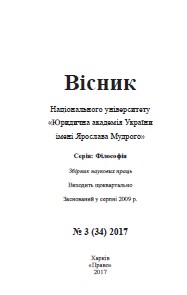ДЕКОНСТРУКЦІЯ КАЛІГРАМИ І ПРАВОВОГО ПОЛЯ (АНАЛІЗ СТРУКТУРНОЇ ДИНАМІКИ)
DECONSTRUCTION OF CALLIGRAM AND LEGAL FIELD (ANALYSIS OF STRUCTURAL DYNAMICS)
Author(s): J. V. MelyakovaSubject(s): Philosophy of Law, Hermeneutics, Ontology
Published by: Національний юридичний університет імені Ярослава Мудрого
Keywords: the dynamism; the plurality of ontological measurements; the text; the reality; the deconstruction; the calligram; the virtuality; the performativity;
Summary/Abstract: The application of the principle of intertextuality in the hermeneutic ontology of law is an attempt to impart dynamism to law in order to better manifest its essence. During the study, all forms of being of law – an event, norm, process, action, decision – are considered as a performative nomological metatext. This text should be interpreted by the subject of law in the process of understanding the person’s existence. The deconstruction of the reality of law in its various dimensions and structures allows us to comprehend the whole diversity of meanings and the multifaceted nature of the existence of law, to feel the specific historical character of law, its spontaneous situational breathing. The law is such that it changes with reality, man and life. The reality of law manifests itself as a set of symbolic systems of diverse nature, they enter into interaction with each other in a performance that is artificially constructed by an understanding person. A legal text focused on the regulation of the individual wills of subjects must always be adapted to their spontaneous nature, and also directed at the specific manifestation of the legal person in all its unpredictability. Thus, the meanings of the performative legal text flicker along with the numerous free actions of those who realize and understand the law. The intrinsic value of law manifests itself depending on the effectiveness of the «articulation» of the forms of law and its means in achieving justice. Deconstructive analysis of the law is aimed at distinguishing separate realities of law: social-practical (act, action), normative-institutional (law, norm), symbolic-interpretational (legal decision, process). Symbolic reality of law (this is a text) in the deconstruction acts as a dynamic space and demonstrative and formation of law, the field of its infinite selfmanifestation. The deconstruction gives the possibility of the reverse movement in the horizon of law: the movement from the ready legal meaning to the reality of the event of law. With the help of a conditional opposition of all its realities (the legal decision – norm – act), the law manifests it’s the authenticity. The authenticity spills through the crevices between the uncoordinated layers of his existence, which are deconstructed. The legal text as a semantic reality has its own characteristics and expressive possibilities – a certain performativity. The performativity of law is manifested primarily in its simulative mode of being-proper. The being-proper is potentially aimed at the norm and absolutely concrete action leading to the application of this norm. It is the performative legal text that adequately reflects the dynamism of the reality of law. The legal text or statement is considered here as a virtual existence of law, due to the arbitrary operation in it of logical modalities.
Journal: Вісник НЮУ імені Ярослава Мудрого. Серія: Філософія, філософія права, політологія, соціологія
- Issue Year: 34/2017
- Issue No: 3
- Page Range: 65-80
- Page Count: 16
- Language: Ukrainian

